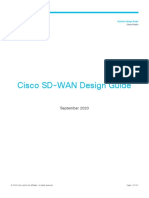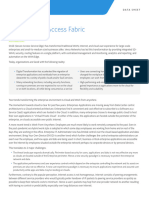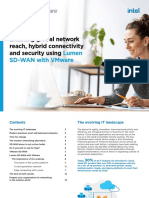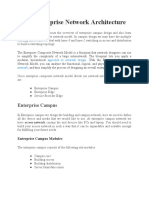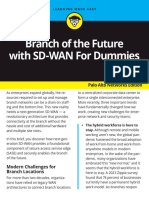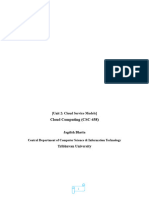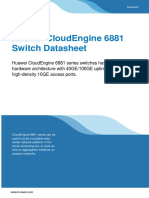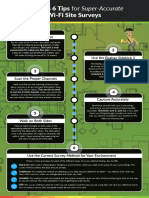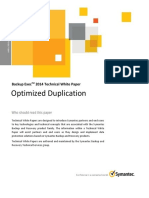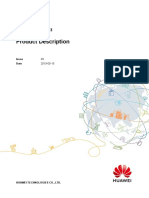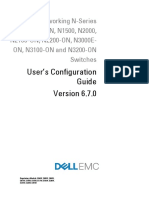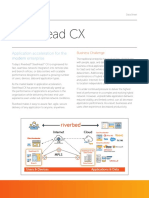Huawei SD-WAN Solution Datasheet
Huawei SD-WAN Solution Datasheet
Uploaded by
Eduardo SoberanisCopyright:
Available Formats
Huawei SD-WAN Solution Datasheet
Huawei SD-WAN Solution Datasheet
Uploaded by
Eduardo SoberanisCopyright
Available Formats
Share this document
Did you find this document useful?
Is this content inappropriate?
Copyright:
Available Formats
Huawei SD-WAN Solution Datasheet
Huawei SD-WAN Solution Datasheet
Uploaded by
Eduardo SoberanisCopyright:
Available Formats
Huawei SD-WAN Solution Datasheet
Huawei SD-WAN Solution is purpose-built to provide full-scenario on-demand interconnections between
branches, between branches and data centers, and between branches and clouds. Standing out with features
such as application-based intelligent traffic steering and acceleration as well as intelligent O&M, this solution
redefines full-process service experience in enterprise WAN interconnections.
Trends and Challenges Facing Enterprise Networks
With the continuous cloudification of enterprise IT architectures and widespread use of public clouds, increasingly more
enterprises are starting to shift their infrastructures (such as enterprise data centers) to the cloud, abandon traditional closed IT
architectures, and instead use open network architectures. To further this, enterprises' mission-critical applications are migrated
onto the cloud, such as the office, production ERP system, and sales system. Under this situation, enterprises increasingly rely
on the Software as a Service (SaaS) provided by application service providers, and prefer to access key applications required
for daily office work from the cloud through the Internet.
Cloud transformation is more than a technical revolution, but more importantly, a business model innovation. As enterprises
migrate their branch services to the cloud, they face new challenges including the following:
Breaking traditional closed WAN architectures and achieving agile WAN interconnections
Digitalization and globalization require enterprise branch sites to interconnect quickly with each other through diversified
carrier access networks across wider areas. In the next few years, more enterprise services will be deployed on the cloud,
and the legacy branches, headquarters, and data centers of enterprises will need to be more open and more flexibly
connect to the Internet, public clouds, and SaaS applications. Under this situation, the key to successful digital
transformation of enterprises is to efficiently and rapidly interconnect enterprise WANs through different carrier networks to
meet their huge, complex organization and service interconnection demands.
Ensuring application experience despite bandwidth sharing by massive numbers of applications and service
conflicts
The rapid development of the Internet has seen the coverage and performance of networks increase considerably.
Internet-based networks are now becoming the primary choice for enterprises apart from traditional private lines, but a
major drawback of them is that service quality cannot be guaranteed. In addition, traditional networks lack insights into
services and cannot learn the status of applications. If burst traffic causes link congestion or quality deterioration,
experience of mission-critical services cannot be guaranteed.
Accelerating service rollouts to meet the requirements for flexible service deployment
On traditional private line networks, service provisioning is slow and usually takes one to three months. As enterprise
services are updated rapidly in the cloudification area, traditional networks cannot meet the fast service rollout and service
flexibility expectations of enterprises.
Simplifying network O&M and changing traditional O&M paradigms (inadequate support for diversified device
types, inefficient and error-prone manual configuration through the CLI due, service traffic invisibility, and low
O&M efficiency)
Traditional O&M requires highly skilled dedicated personnel to maintain devices on site. As enterprise branches are
becoming more widely distributed across geographical locations, the number and types of devices are increasing sharply,
making traditional O&M challenging and costly. Additionally, the increase and cloudification of services complicate traffic
transmission from branches to branches, public clouds, and private clouds on WANs, and therefore traditional network
O&M methods can no longer adapt to service development.
Huawei SD-WAN Solution Datasheet 1
Huawei SD-WAN Solution
Huawei SD-WAN Solution addresses the issues facing enterprise networks, including closed WAN architectures, difficult service
experience guarantee, slow service rollout, and difficult O&M. This solution provides full-scenario on-demand interconnections
between branches, between branches and data centers, and between branches and clouds. With compelling features such as
application-based intelligent traffic steering and acceleration as well as intelligent O&M, the SD-WAN Solution redefines full-
process service experience in enterprise WAN interconnections.
Architecture of Huawei SD-WAN Solution
The overall architecture of Huawei's SD-WAN Solution comprises the network connection layer, control layer, and management
layer.
Overall Architecture of the SD-WAN Solution
Network connection layer
Enterprises deploy cost-effective NetEngine 5G AR routers and use overlay technology to build full network
interconnections between the headquarters, branches, and public or private clouds on demand through links such as
Internet links and traditional private lines.
Control layer
Reflect routers (RRs) work with iMaster NCE-WAN to implement automatic deployment and configuration of networks in
each area, automatic policy provisioning, route transfer between sites in each area, and inter-area network interconnection.
Management layer
iMaster NCE-WAN implements full-process management on enterprise interconnection services. In the southbound
direction, iMaster NCE-WAN uses NETCONF/YANG to implement unified management of devices such as RRs and CPEs,
CPE-RR mapping and orchestration, configuration and orchestration of different virtual private network (VPN) topologies,
as well as management and provisioning of network service policies. In the northbound direction, iMaster NCE-WAN
provides standard RESTful APIs for easy interconnection with third-party applications and the cloud platforms.
Huawei SD-WAN Solution Datasheet 2
Characteristics of Huawei SD-WAN Solution
5G ultra-broadband for on-demand interconnection
The full lineup of NetEngine AR6000 series routers supports 5G uplinks. As the first-of-its-kind enterprise-class 5G uplink
access routers, Huawei 5G AR routers support full modes (5G, 4G, and 3G) using a single chipset and allow for both the
standalone (SA) and non-standalone (NSA) network architectures.
5G gigabit wireless and ultra-broadband connection: The SD-WAN Solution enables service provisioning within
minutes at any site, and also supports per-flow load balancing for improved 5G link utilization.
Flexible networking and on-demand service interconnection: Huawei 5G AR routers provide various wired and
wireless WAN interfaces, and support the hub-spoke, full-mesh, and partial-mesh networking options. Customers can
flexibly select single-layer or multi-layer networking best tailored to their network scale and needs. Carriers can also deploy
multi-tenant high-performance CPEs as gateways to provide enterprise tenants with services for interconnection with
traditional private line networks and POP networking services. The multi-tenant interworking gateway (IWG) provides
flexible access between SD-WAN sites and legacy MPLS sites, facilitating smooth evolution of legacy enterprise networks
to SD-WAN networks.
Large-scale networking: Up to 20,000 CPEs can be networked, fulfilling the multi-branch interconnection requirement of
large enterprises.
Multiple cloud access modes and one-hop service connection to the cloud: The SD-WAN Solution allows tunnels to
be established between branch CPEs and private clouds, so that service traffic is transmitted one-hop from branch sites to
private clouds. Through the IWG, a carrier can provide enterprises with communication between SD-WAN and legacy
networks, allowing for one-hop connection of branch sites to the MPLS backbone network. This solution also supports local
Internet access or centralized Internet access through the headquarters for access to cloud SaaS services.
Intelligent traffic steering for outstanding experience
Application-based intelligent traffic steering, guaranteeing service experience. Huawei SD-WAN Solution supports
abundant application identification technologies. First-packet identification (FPI), service awareness (SA), and customized
application identification combine to double the application identification accuracy and efficiency. In-line detection
technology is used to implement multi-dimensional optimal route selection based on the application SLA, application
priority, and bandwidth utilization, ensuring that the traffic of mission-critical applications is transmitted over the optimal link.
Application optimization for enhanced experience: The innovative adaptive forward error correction (A-FEC)
mechanism embedded with quality awareness ensures lossless experience of audio and video applications even when the
packet loss rate is 20%.
End-to-end encryption for secure interconnection: End-to-end IPsec encryption as well as secure and reliable devices
ensure secure service transmission and secure interconnection with third-party security clouds.
Integrated management and control, and intelligent O&M
Simplified deployment: Various zero touch provisioning (ZTP) methods are provided to implement device plug-and-play
with zero site visits. The application-centric wizard-based configuration automates the entire process from device
deployment, network orchestration, and application policies, to visualized O&M, shortening the service configuration time
from 30 minutes to 5 minutes.
Visualized O&M: The SD-WAN Solution supports topology visualization based on applications, links, sites, and the entire
network, and also supports more than 40 agile reports.
Unified WAN, LAN, and security management: One set of iMaster NCE-WAN can manage and control switches, Wi-Fi
devices, routers, and firewalls.
Application Scenarios of Huawei SD-WAN Solution
Enterprise-Built SD-WAN Interconnection
Large enterprises with distributed branch sites, diversified service types, and high requirements on private line quality can
deploy their own iMaster NCE-WAN systems to manage SD-WAN networks. This can help them overcome challenges such as
explosive growth of service traffic, poor experience of mission-critical applications, and difficult O&M.
Enterprise SD-WAN Solution:
An enterprise deploys one set of iMaster NCE-WAN to manage its own SD-WAN services.
Huawei SD-WAN Solution Datasheet 3
The enterprise headquarters and branches can use dual CPEs as gateways and access the network through both MPLS and
Internet links, meeting the high quality requirements for private lines. Sites where wired links are unavailable can also use LTE
links to access the network. CPEs at the headquarters or large branch sites can function as RRs. Independent devices can also
be deployed as RRs.
Hierarchical QoS policies and bandwidth- or application-based intelligent traffic steering are configured to ensure experience of
mission-critical services, implement load balancing, and improve bandwidth utilization.
This solution provides ZTP, automatic service orchestration and delivery, multi-dimensional visualized management for links and
services, and various fault diagnosis and inspection tools to simplify network deployment and O&M of a large number of
branches.
Enterprise-built SD-WAN Interconnection Scenario
Carrier SD-WAN Multi-Tenant Scenario
Carriers need to provide network deployment and O&M services for enterprises of different scales in various industries, helping
enterprises quickly complete network deployment and service rollout. In addition, carriers transform from network pipe providers
to service providers to provide network and value-added services for enterprises.
Carrier SD-WAN Solution:
Carriers use the multi-tenant mode of iMaster NCE-WAN to deploy multi-tenant-capable RRs so that SD-WAN networks are
available for multiple enterprises. Enterprises are tenants, leasing the SD-WAN networks of carriers. For security, tenants are
isolated and are invisible to each other, and each tenant independently maintains its own SD-WAN network.
Enterprise branches can flexibly connect to the Internet through multiple links to communicate with other branches and access
SaaS applications. Tenants can select hierarchical QoS policies, as well as intelligent traffic steering and security policies based
on the link quality, application priority, bandwidth utilization, and load balancing to ensure experience of key services, improve
bandwidth utilization, and achieve optimal security.
Carriers use the visualized O&M system of iMaster NCE-WAN to maintain SD-WAN networks and provide VASs for enterprises.
An enterprise network needs to support communication between SD-WAN sites and legacy branch sites to meet the operation
requirements of inventory customer assets. Carriers can deploy IWGs that support the multi-tenant function to interconnect with
Autonomous System Boundary Routers (ASBRs) on legacy networks. In addition, this solution meets the interconnection
requirements of multiple SD-WAN sites and legacy branch sites.
Huawei SD-WAN Solution Datasheet 4
Carrier SD-WAN Multi-Tenant Scenario
Huawei SD-WAN Solution Products
The SD-WAN Solution consists of the following components: iMaster NCE-WAN, RRs, and CPEs. The following table describes
the functions of each component.
Component Product Function
Provides centralized and automated
Controller iMaster NCE-WAN
management of network devices.
Distributed control Distributes VPN route and tunnel
RR
component information between CPEs.
NetEngine AR6000 and AR600 series
NetEngine 5G AR branch access routers,
CPE routers, such as NetEngine AR651 and
which all support SD-WAN
NetEngine AR6280
Huawei SD-WAN Solution Datasheet 5
More Information
For more information, visit https://e.huawei.com/en/ or contact us in the following ways:
● Global service hotline: http://e.huawei.com/en/service-hotline
● Logging in to the Huawei Enterprise technical support website: http://support.huawei.com/enterprise/
● Sending an email to the customer service mailbox: support_e@huawei.com
Copyright © Huawei Technologies Co., Ltd. 2020. All rights reserved.
No part of this document may be reproduced or transmitted in any form or by any means without prior written
consent of Huawei Technologies Co., Ltd.
Trademarks and Permissions
and other Huawei trademarks are trademarks of Huawei Technologies Co., Ltd.
All other trademarks and trade names mentioned in this document are the property of their respective holders.
Notice
The purchased products, services and features are stipulated by the contract made between Huawei and the
customer. All or part of the products, services and features described in this document may not be within the
purchase scope or the usage scope. Unless otherwise specified in the contract, all statements, information, and
recommendations in this document are provided "AS IS" without warranties, guarantees or representations of any Huawei Technologies Co., Ltd.
kind, either express or implied. Address: Huawei Industrial Base
The information in this document is subject to change without notice. Every effort has been made in the Bantian, Longgang Shenzhen 518129
preparation of this document to ensure accuracy of the contents, but all statements, information, and People's Republic of China
recommendations in this document do not constitute a warranty of any kind, express or implied. Website: www.huawei.com
Huawei SD-WAN Solution Datasheet 6
You might also like
- Learning SD-WAN with Cisco: Transform Your Existing WAN Into a Cost-effective NetworkFrom EverandLearning SD-WAN with Cisco: Transform Your Existing WAN Into a Cost-effective NetworkNo ratings yet
- Helix Service Assurance SDWAN BrochureDocument8 pagesHelix Service Assurance SDWAN BrochureManoj SamarakoonNo ratings yet
- Cisco Sdwan Design GuideDocument102 pagesCisco Sdwan Design GuideSheik ShareefNo ratings yet
- Huawei SD-WAN Solution DatasheetDocument9 pagesHuawei SD-WAN Solution Datasheetkareem saleemNo ratings yet
- Huawei SD-WAN Solution DatasheetDocument10 pagesHuawei SD-WAN Solution DatasheetJUAN DE JESUS ACEVEDO CABALLERONo ratings yet
- Sd-Wan Overview: Vmware Special EditionDocument6 pagesSd-Wan Overview: Vmware Special EditionEduardo SoberanisNo ratings yet
- SO SDBranchDocument5 pagesSO SDBranchhcm daukhiNo ratings yet
- Versa Secure SD WanDocument4 pagesVersa Secure SD WanAziz NugrohoNo ratings yet
- AAG - Key SD WAN Use CasesDocument3 pagesAAG - Key SD WAN Use Caseshcm daukhiNo ratings yet
- 1.huawei CloudWAN Solution BrochureDocument6 pages1.huawei CloudWAN Solution Brochuremarcoant2287No ratings yet
- Securevate Sd-WanDocument16 pagesSecurevate Sd-WanankitaNo ratings yet
- Virtualized Network Services: Transcend Connectivity and Empower IT With SD-WAN 2.0Document9 pagesVirtualized Network Services: Transcend Connectivity and Empower IT With SD-WAN 2.0Barry ZhuNo ratings yet
- What Is SD-WANDocument7 pagesWhat Is SD-WANMoazzam TiwanaNo ratings yet
- Sd-Wan For Enterprises: Vmware Special EditionDocument5 pagesSd-Wan For Enterprises: Vmware Special EditionEduardo SoberanisNo ratings yet
- SD WanDocument7 pagesSD Wangandalf56No ratings yet
- VeloCloud Lab Hol 2140 91 Ism - PDF - enDocument19 pagesVeloCloud Lab Hol 2140 91 Ism - PDF - enpaulo_an7381No ratings yet
- Chapter 5Document16 pagesChapter 5Hina SaeedNo ratings yet
- Untangle Get Started With SD Wan e BookDocument15 pagesUntangle Get Started With SD Wan e BookEko Andri PrasetyoNo ratings yet
- (Ijcst-V12i6p6) :sahanashree GDocument5 pages(Ijcst-V12i6p6) :sahanashree Geditor1ijcstNo ratings yet
- Versa Secure Access FabricDocument5 pagesVersa Secure Access Fabricchetan21kathaitNo ratings yet
- Sdwan FinalDocument26 pagesSdwan Finalapi-358888696100% (2)
- Sophos SD Wan Use CasesDocument11 pagesSophos SD Wan Use CasesravinaiduNo ratings yet
- Lumen SD-WAN With VMware Ebook - Final - 1631121818322001pmS6Document13 pagesLumen SD-WAN With VMware Ebook - Final - 1631121818322001pmS6pramodNo ratings yet
- Telecom Network Design Final Topics FilesDocument20 pagesTelecom Network Design Final Topics FilesR Adil waheedNo ratings yet
- SDWan A Simplified Network For Distributed Enterprises EbookDocument20 pagesSDWan A Simplified Network For Distributed Enterprises EbookSaravanan Veerayah JayaramanNo ratings yet
- Ebook Required Capabilities For Effective and Secure SD Wan The Network Leader S GuideDocument19 pagesEbook Required Capabilities For Effective and Secure SD Wan The Network Leader S GuideAlvish SuttonNo ratings yet
- SD WAN Three Use Cases For TransformingDocument8 pagesSD WAN Three Use Cases For TransformingduartefrancoNo ratings yet
- Cisco SDWANDocument2 pagesCisco SDWANkishoreibusNo ratings yet
- Cisco Business Ready Wan and Man: Solutions OverviewDocument13 pagesCisco Business Ready Wan and Man: Solutions OverviewVictoria LevinteNo ratings yet
- Cisco Virtual WAAS: Cloud-Ready WAN Optimization SolutionDocument5 pagesCisco Virtual WAAS: Cloud-Ready WAN Optimization SolutionMichael LeonardNo ratings yet
- WP SDBranchOverviewDocument11 pagesWP SDBranchOverviewkalila rifdaNo ratings yet
- Cisco Controller Based WLANDocument4 pagesCisco Controller Based WLANjumyarif2905No ratings yet
- SD - WAN PresentationDocument13 pagesSD - WAN Presentationami.kwara1No ratings yet
- Gartner Market Guide For SD WanDocument23 pagesGartner Market Guide For SD WanedyNo ratings yet
- Untangle Whitepaper Securing The Distributed Enterprise With SD WanDocument3 pagesUntangle Whitepaper Securing The Distributed Enterprise With SD WanRajeev AroraNo ratings yet
- SD WAN Aruba Software and GatewaysDocument14 pagesSD WAN Aruba Software and GatewaysIngKarasuma1No ratings yet
- Loudgenix SD Wan AagDocument1 pageLoudgenix SD Wan AagtestNo ratings yet
- SD Wan 1592482748Document6 pagesSD Wan 1592482748Florick Le MahamatNo ratings yet
- Distributed Cloud White Paper - FinalDocument11 pagesDistributed Cloud White Paper - FinalChaly KhoaNo ratings yet
- Gartner Magic Quadrant For Network Services Global March 2021Document28 pagesGartner Magic Quadrant For Network Services Global March 2021ta peiNo ratings yet
- Analyzing Business Goals, Constraints and Sizing of WAN NetworkDocument22 pagesAnalyzing Business Goals, Constraints and Sizing of WAN NetworkdereNo ratings yet
- Abc of NSX SDWAN - VelocloudDocument114 pagesAbc of NSX SDWAN - VelocloudneoaltNo ratings yet
- What Is Network Virtualization? Everything You Need To KnowDocument8 pagesWhat Is Network Virtualization? Everything You Need To KnowjonahNo ratings yet
- Branch of The Future With SD-Wan For DummiesDocument6 pagesBranch of The Future With SD-Wan For DummiesYaya AbatanNo ratings yet
- WAN Technologies AssignmentDocument13 pagesWAN Technologies AssignmentDavid Cleary100% (1)
- Data Redundancy Elimination (DRE) Technology To Identify: Secure ConnectivityDocument15 pagesData Redundancy Elimination (DRE) Technology To Identify: Secure ConnectivityPriscila FloresNo ratings yet
- SD WAN Architecture 1621768797Document10 pagesSD WAN Architecture 1621768797Shakeel AminNo ratings yet
- Unit 2Document30 pagesUnit 2Shilpa bhattNo ratings yet
- Unit V NDDocument24 pagesUnit V NDp rajeshwariNo ratings yet
- Optimizing Your Network For The Cloud First WorldDocument9 pagesOptimizing Your Network For The Cloud First WorldHilmanBukhariNo ratings yet
- Eb Network Leaders Guide To SD WAN PDFDocument17 pagesEb Network Leaders Guide To SD WAN PDFAayushNo ratings yet
- Ccna 4E Chapter 1 Introduction To Wans V 4.0 March 2008: Developed by General DynamicsDocument6 pagesCcna 4E Chapter 1 Introduction To Wans V 4.0 March 2008: Developed by General DynamicsWagner CostaNo ratings yet
- Affirmed Networks Network Slicing WhitepaperDocument12 pagesAffirmed Networks Network Slicing WhitepaperALEXANDRE JOSE FIGUEIREDO LOUREIRONo ratings yet
- Building and Maintaining Effective Cloud Computing InfrastructuresDocument8 pagesBuilding and Maintaining Effective Cloud Computing InfrastructuresBâte NicolaeNo ratings yet
- Speedcast Sd-Wan: Maximizing Your BandwidthDocument2 pagesSpeedcast Sd-Wan: Maximizing Your Bandwidthcarlos.rodriguezq2022No ratings yet
- Next-Generation WAN: Connecting, People, Places, and ThingsDocument11 pagesNext-Generation WAN: Connecting, People, Places, and ThingsAdry CarrilloNo ratings yet
- What Is The Cisco SD-WAN Solution?Document56 pagesWhat Is The Cisco SD-WAN Solution?Azizuddin AhmedNo ratings yet
- Cloud Computing and Virtualization: Streamlining Your IT InfrastructureFrom EverandCloud Computing and Virtualization: Streamlining Your IT InfrastructureNo ratings yet
- Meraki MSP Guide 2021 ESDocument21 pagesMeraki MSP Guide 2021 ESEduardo SoberanisNo ratings yet
- InsectsforfoodandfeedDocument5 pagesInsectsforfoodandfeedEduardo SoberanisNo ratings yet
- AWS Partner EbookDocument27 pagesAWS Partner EbookEduardo SoberanisNo ratings yet
- Fly Me To The Moon en CDocument1 pageFly Me To The Moon en CEduardo SoberanisNo ratings yet
- CloudEngine 6881 Series Data Center Switches Data SheetDocument14 pagesCloudEngine 6881 Series Data Center Switches Data SheetEduardo SoberanisNo ratings yet
- 6 Tips Site Survey PosterDocument1 page6 Tips Site Survey PosterEduardo SoberanisNo ratings yet
- PowerEdge PortfolioDocument85 pagesPowerEdge PortfolioEduardo SoberanisNo ratings yet
- Backup Exec 2014 Optimized Duplication White PaperDocument19 pagesBackup Exec 2014 Optimized Duplication White PaperEduardo SoberanisNo ratings yet
- Reasons To Upgrade To NetBackup 8.1.2Document2 pagesReasons To Upgrade To NetBackup 8.1.2Eduardo SoberanisNo ratings yet
- Huawei OceanStor 2200 V3 Storage Systems Product DescriptionDocument128 pagesHuawei OceanStor 2200 V3 Storage Systems Product DescriptionEduardo SoberanisNo ratings yet
- Networking n1500 Series User's Guide15 en UsDocument1,794 pagesNetworking n1500 Series User's Guide15 en UsEduardo SoberanisNo ratings yet
- Layer 2 Leaf & Spine Design and Deployment GuideDocument26 pagesLayer 2 Leaf & Spine Design and Deployment GuideEduardo SoberanisNo ratings yet
- ERP Fundamentals - Student GuideDocument202 pagesERP Fundamentals - Student GuideEduardo SoberanisNo ratings yet
- Vmware SD Wan by Velocloud Overview - 551681Document5 pagesVmware SD Wan by Velocloud Overview - 551681Eduardo SoberanisNo ratings yet
- Sd-Wan For Enterprises: Vmware Special EditionDocument5 pagesSd-Wan For Enterprises: Vmware Special EditionEduardo SoberanisNo ratings yet
- SD WAN Edge VeloCloud DSDocument8 pagesSD WAN Edge VeloCloud DSEduardo SoberanisNo ratings yet
- Catalyst 1000Document1 pageCatalyst 1000Eduardo SoberanisNo ratings yet
- Velocloud Sd-Wan Subscription: Enterprise/Premium Subscription DatasheetDocument6 pagesVelocloud Sd-Wan Subscription: Enterprise/Premium Subscription DatasheetEduardo Soberanis100% (1)
- Future of Sd-Wan: Vmware Special EditionDocument4 pagesFuture of Sd-Wan: Vmware Special EditionEduardo SoberanisNo ratings yet
- Cinderella PoemDocument3 pagesCinderella PoemEduardo SoberanisNo ratings yet
- KFS Software Information Ver 042018 - enDocument31 pagesKFS Software Information Ver 042018 - enHoratiu OanaNo ratings yet
- Email Marketing Templates: How To Content MarketingDocument8 pagesEmail Marketing Templates: How To Content MarketingAdvicisom AdminNo ratings yet
- Release Notes RW 6.05Document33 pagesRelease Notes RW 6.05desenvolvimentoservnewsNo ratings yet
- TBC Log 231101 105654Document5 pagesTBC Log 231101 105654Victor LimacoNo ratings yet
- AWS Competency Application Readiness Checklist: Topic DescriptionDocument3 pagesAWS Competency Application Readiness Checklist: Topic DescriptionIgnacio JuriNo ratings yet
- React Pokatamon - HackMDDocument13 pagesReact Pokatamon - HackMDSantiago LlanosNo ratings yet
- Panasonic The cx350 Book - BrochureDocument226 pagesPanasonic The cx350 Book - Brochurecloudless_inkNo ratings yet
- The Evolution of Social MediaDocument2 pagesThe Evolution of Social MediaJoice Sandra Ganadi100% (1)
- Monthly Startup Update - TEMPLATEDocument3 pagesMonthly Startup Update - TEMPLATEJohnNo ratings yet
- Mining Proxy Logs - Matthew MyrickDocument29 pagesMining Proxy Logs - Matthew MyrickAbdul Rahaman GaffarNo ratings yet
- Steelhead CX: Application Acceleration For The Modern EnterpriseDocument3 pagesSteelhead CX: Application Acceleration For The Modern EnterpriseRuben FrioNo ratings yet
- Assignment 5.2 System UtilitiesDocument4 pagesAssignment 5.2 System UtilitiesDhan GaringanNo ratings yet
- Manuscript Submission Checklist: Required ElementsDocument1 pageManuscript Submission Checklist: Required ElementsGalal Eldien GalalNo ratings yet
- Co-Simulation With SpectreRF Matlab Simulink TutorialDocument34 pagesCo-Simulation With SpectreRF Matlab Simulink TutorialluminedinburghNo ratings yet
- SECS04L07 - Configuring Cisco IOS SSL VPN (WebVPN)Document37 pagesSECS04L07 - Configuring Cisco IOS SSL VPN (WebVPN)Khoa Huynh DangNo ratings yet
- LAB 04 Packet Tracer - Implement Basic ConnectivityDocument3 pagesLAB 04 Packet Tracer - Implement Basic ConnectivityCorrine LozanoNo ratings yet
- ZYXEL Users-Guide NR7101 Version 1.00Document267 pagesZYXEL Users-Guide NR7101 Version 1.00Anthony DeroyNo ratings yet
- The 1st Page Sage - Unlocking The SEODocument171 pagesThe 1st Page Sage - Unlocking The SEOAbhayNo ratings yet
- Instant Prepaid Top Up: AcceptedDocument1 pageInstant Prepaid Top Up: Accepted大衛龍No ratings yet
- Bhavsar 2018 Ijca 918286Document4 pagesBhavsar 2018 Ijca 918286saidiNo ratings yet
- AWS CCP Practice Exam 4 - Digital Cloud TrainingDocument82 pagesAWS CCP Practice Exam 4 - Digital Cloud Trainingkazmi5412No ratings yet
- SaToSa TrainingDocument39 pagesSaToSa TrainingFrancisco José Aragó MonzonísNo ratings yet
- LNMIIT Admission Application FormDocument3 pagesLNMIIT Admission Application FormGeorge ParmerNo ratings yet
- WAC 4.2 - User - GuideDocument54 pagesWAC 4.2 - User - Guideineon03No ratings yet
- TM Cart Customer UI DocumentDocument11 pagesTM Cart Customer UI DocumentAlan GeorgeNo ratings yet
- Chapter 1 - Routing ConceptsDocument56 pagesChapter 1 - Routing ConceptsThái Phúc LưuNo ratings yet
- Step Procedure To Install CN510: Ahmed Bebars Ericsson 5/19/2013Document40 pagesStep Procedure To Install CN510: Ahmed Bebars Ericsson 5/19/2013Oscar SiriasNo ratings yet
- Cilium Annual Report 2022Document15 pagesCilium Annual Report 2022Amrish MauryaNo ratings yet
- CRPC Handwritten Notes. - PDFDocument87 pagesCRPC Handwritten Notes. - PDFRaghul FabNo ratings yet
- Drone Application in Smart Cities: The General Overview of Security Vulnerabilities and Countermeasures For Data CommunicationDocument27 pagesDrone Application in Smart Cities: The General Overview of Security Vulnerabilities and Countermeasures For Data CommunicationSupriya PoudelNo ratings yet


